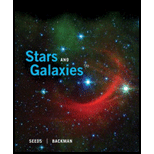
Stars and Galaxies
9th Edition
ISBN: 9781305120785
Author: Michael A. Seeds, Dana Backman
Publisher: Cengage Learning
expand_more
expand_more
format_list_bulleted
Question
Chapter 4, Problem 6P
To determine
The average distance of uranus from sun.
Expert Solution & Answer
Want to see the full answer?
Check out a sample textbook solution
Students have asked these similar questions
The solar system has a planet with an orbital period T1b=1.51d and an orbital radius of R1b=1.6456x10^6km. Another planet in the system has an orbital radius of R1f=5.5352x10^6 km. Calculate its orbital period in days.
Asteroid Ondrea has a semi-major axis of 2.99 AU. What is Ondrea's orbital period in years about the sun ?
Saturn's mass is M= 5.69 x 1026 kg and its radius R=60,300 km. If a moon orbits Saturn at a distance equal to 5 times its
planetary radius, what is its period of orbit? (Hint, use Newton's version of Kepler's 3rd law, and you can neglect the
mass of the moon) Express your answer in days to three significant figures.
Chapter 4 Solutions
Stars and Galaxies
Ch. 4 - Prob. 1RQCh. 4 - Prob. 2RQCh. 4 - Prob. 3RQCh. 4 - Prob. 4RQCh. 4 - Prob. 5RQCh. 4 - Prob. 6RQCh. 4 - Which two-dimensional (2D) and three-dimensional...Ch. 4 - Prob. 8RQCh. 4 - Prob. 9RQCh. 4 - Prob. 11RQ
Ch. 4 - Prob. 12RQCh. 4 - Prob. 13RQCh. 4 - Prob. 14RQCh. 4 - Prob. 16RQCh. 4 - Prob. 17RQCh. 4 - Prob. 18RQCh. 4 - Prob. 19RQCh. 4 - Prob. 20RQCh. 4 - Prob. 21RQCh. 4 - Prob. 22RQCh. 4 - How did the Alfonsine Tables, the Prutenic Tables,...Ch. 4 - Prob. 24RQCh. 4 - Prob. 25RQCh. 4 - Prob. 26RQCh. 4 - Prob. 27RQCh. 4 - Draw and label a diagram of the western horizon...Ch. 4 - Prob. 2PCh. 4 - Prob. 3PCh. 4 - Prob. 4PCh. 4 - Prob. 5PCh. 4 - Prob. 6PCh. 4 - One planet is three times farther from the Sun...Ch. 4 - Prob. 9PCh. 4 - Prob. 10PCh. 4 - Prob. 11PCh. 4 - Prob. 1LLCh. 4 - Prob. 2LLCh. 4 - What three astronomical objects are represented...Ch. 4 - Prob. 4LL
Knowledge Booster
Learn more about
Need a deep-dive on the concept behind this application? Look no further. Learn more about this topic, physics and related others by exploring similar questions and additional content below.Similar questions
- Phobos, one of the moons of Mars, orbits at a distance of 9378 km from the center of the red planet. What is the orbital period of Phobos?arrow_forwardSaturn orbits the Sun at a distance of 9.58 times the distance from the Earth to the Sun.How long does a year last on Saturn?arrow_forwardNeptune circles the Sun at a distance of 4.30 x 10^12 m once every 164 yeras. Saturn circles the Sun at a distance 1.43 x 10^12 m. Orbital period of Saturn?arrow_forward
- A meteor with a mass of 7.48 x 104 kg and is orbiting 408,819 meters above the Earth and at the speed of 5,068 m/s. What is the centripetal acceleration?arrow_forwardThe planet Saturn has a mass of 5.68×10^26 kg and a radius of 58,200 km. Janus, a moon of Saturn, has a mass of 1.9×10^18 kg and it orbits Saturn a distance of 151,400 km from the center of Saturn. - How many hours does it take for Janus to orbit Saturn?arrow_forwardScientist once hypothesized the existence of a planet called vulcan to explain Mercury's precession. Vulcan is supposed to be between mercury and the sun with a solar distance equal to 2/3;of that mercury. What would be its supposed periodarrow_forward
- Saturn has an orbital period of 29.6 years. Explain how to calculate the average distance from the saturn to the sunarrow_forwardThe distance from the sun to saturn is approximatelyarrow_forwardCeres, the largest asteroid and a dwarf planet, has a semi-major axis of about 2.74 AU. What is Ceres' orbital period in years about the Sun ?arrow_forward
- The dwarf planet Praamzius is estimated to have a diameter of about 300 km and orbits the sun at a distance of 6.8×10^12m. What is its orbital period in years? Express your answer in years to three significant figures.arrow_forwardAn asteroid orbiting the sun has a semi major axis of 3.0 AU. What is the period of its orbit in yearsarrow_forwardWhat is the length of the 60-degree arc whose radius is 10m?arrow_forward
arrow_back_ios
SEE MORE QUESTIONS
arrow_forward_ios
Recommended textbooks for you
 AstronomyPhysicsISBN:9781938168284Author:Andrew Fraknoi; David Morrison; Sidney C. WolffPublisher:OpenStax
AstronomyPhysicsISBN:9781938168284Author:Andrew Fraknoi; David Morrison; Sidney C. WolffPublisher:OpenStax An Introduction to Physical SciencePhysicsISBN:9781305079137Author:James Shipman, Jerry D. Wilson, Charles A. Higgins, Omar TorresPublisher:Cengage Learning
An Introduction to Physical SciencePhysicsISBN:9781305079137Author:James Shipman, Jerry D. Wilson, Charles A. Higgins, Omar TorresPublisher:Cengage Learning Principles of Physics: A Calculus-Based TextPhysicsISBN:9781133104261Author:Raymond A. Serway, John W. JewettPublisher:Cengage Learning
Principles of Physics: A Calculus-Based TextPhysicsISBN:9781133104261Author:Raymond A. Serway, John W. JewettPublisher:Cengage Learning Foundations of Astronomy (MindTap Course List)PhysicsISBN:9781337399920Author:Michael A. Seeds, Dana BackmanPublisher:Cengage Learning
Foundations of Astronomy (MindTap Course List)PhysicsISBN:9781337399920Author:Michael A. Seeds, Dana BackmanPublisher:Cengage Learning Stars and Galaxies (MindTap Course List)PhysicsISBN:9781337399944Author:Michael A. SeedsPublisher:Cengage Learning
Stars and Galaxies (MindTap Course List)PhysicsISBN:9781337399944Author:Michael A. SeedsPublisher:Cengage Learning

Astronomy
Physics
ISBN:9781938168284
Author:Andrew Fraknoi; David Morrison; Sidney C. Wolff
Publisher:OpenStax

An Introduction to Physical Science
Physics
ISBN:9781305079137
Author:James Shipman, Jerry D. Wilson, Charles A. Higgins, Omar Torres
Publisher:Cengage Learning

Principles of Physics: A Calculus-Based Text
Physics
ISBN:9781133104261
Author:Raymond A. Serway, John W. Jewett
Publisher:Cengage Learning

Foundations of Astronomy (MindTap Course List)
Physics
ISBN:9781337399920
Author:Michael A. Seeds, Dana Backman
Publisher:Cengage Learning

Stars and Galaxies (MindTap Course List)
Physics
ISBN:9781337399944
Author:Michael A. Seeds
Publisher:Cengage Learning

Kepler's Three Laws Explained; Author: PhysicsHigh;https://www.youtube.com/watch?v=kyR6EO_RMKE;License: Standard YouTube License, CC-BY